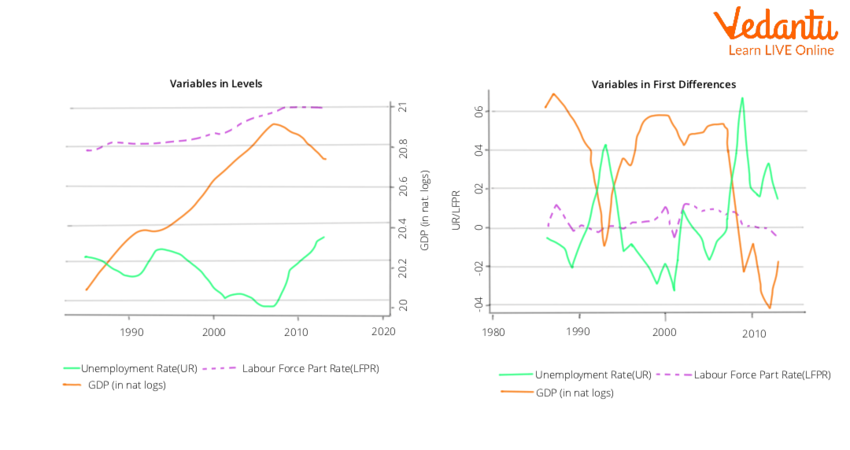




Okun's Law: An Overview
Okun's law, named after economist Arthur Okun, examines the relationship between two important macroeconomic variables, unemployment, and output. According to the statement, "for every 1% reduction in unemployment in an economy, GDP will increase by 2% and GNP will increase by 3%." It implies an inverse relationship between unemployment and GDP and GNP. This statute is well-known for its clarity and precision. Nonetheless, many questions have been raised about this rule, as it is not applicable to every state or economy. To be clear, in an industrialised economy with robust labour markets, the percentage change in GDP has less of an impact on the unemployment rate.
Okun's Law
Okun's law Formula

Okun's Law Formula
Due to the inverse relationship between unemployment and GDP, the output gap—the difference between actual and potential GDP—is equal to the change in unemployment multiplied by the negative Okun coefficient.
The Okun coefficient would always equal 2 according to the conventional version of Okun's law. In today's context, this coefficient may not always be two and may vary depending on the state of the economy.
Okun's Law Meaning and Usefulness
The economic cycle begins with investment. Outside investment benefits any industry in which a corporation is involved. Investment leads to higher production levels, which necessitates more workers, raising the employment rate yet again. As a result, a decrease in the unemployment rate eventually raises the nation's GDP. Product and service sectors, as well as other industries, all contribute to the nation's GDP.
Okun's formula is based on this logic. According to Arthur Okun's Law, for every 1% decrease in unemployment, GDP grows by 2%. However, in today's world, this concept does not apply to all economies. While Okun's law works in the same way—that is, when unemployment rates fall, the nation's GDP rises, and vice versa—the Okun Coefficient varies from country to country depending on economic circumstances.

Okun's Law Economic Growth and Unemployment
Why do GDP and unemployment rates differ?
GDP expands and contracts faster than the unemployment rate for a variety of reasons, including a reduction in the multiplier effect produced by workers' money circulation; people with jobs working fewer hours; a potential decline in labour productivity; companies keeping more employees than they need; and the possibility that unemployed people will stop looking for work and leave the labour force, leaving them out of the unemployment data.
Law of increasing state activities
Adolph Wagner, a German economist, conducted a thorough investigation into the rise in public spending in the late nineteenth century. Based on his research, he created "The Law of Increasing State Activity."
Wagnar's Law states that "the activities and duties of the government increase as the economy improves over time."
"Comprehensive comparisons of different countries and different eras," Adolph Wagner writes, "show that among progressive peoples (societies), with whom we are only concerned, an increase in activity regularly occurs in the activity of both the Central Government and Local Governments, constantly undertaking new functions, while performing both old and new functions more efficiently and completely."
Case Study
When is Okun's law useful? Explain with some examples.
The applicability of Okun's law is a point of contention among economists.
Okun's law has been shown to be accurate across our economy. However, the connection is not always strong.
According to the Federal Reserve Bank of Kansas City, Okun's law "has not always been a tight statistical link." According to the study that produced such findings, economists today frequently believe that the relationship between two variables changes over time.
A more recent investigation by the Federal Reserve Bank of St. Louis, on the other hand, supported Okun's Law. Okun's law "may be a useful guide for monetary policy" if the natural rate of unemployment is accurately calculated, according to the statement.
In order to control inflation, the Federal Reserve, for example, could forecast how rising interest rates will affect the unemployment rate. They can then use that information to forecast the impact of rate hikes on economic growth. This law gives them a more precise and comprehensive picture of how their initiatives will impact the economy.
Conclusion
There is no doubt that Okun's law is one of the simplest and most practical ways to investigate the relationship between economic growth and employment. One of the main advantages of Okun's law is how simply it states that when the economy expands by around 2% faster than expected, unemployment falls by 1%. Given the trends in economic development, relying on it to make precise predictions about unemployment is not a good idea. It has been observed, for example, to change over time and to be influenced by more unusual economic environments, such as jobless recoveries and the 2008 financial crisis. The perfect example of this is the GDP ratio of India. The GDP ratio of India is 3.35 times of GDP at nominal.
FAQs on Okun's Law: Unemployment and Economic Growth
1. What is Okun's Law in the context of economic growth and unemployment?
Okun's Law describes an empirically observed, negative relationship between a country's unemployment rate and its real Gross Domestic Product (GDP). In simple terms, it states that when unemployment falls, the country's economic output increases. It was formulated by economist Arthur Okun, who found that for every 1% increase in the unemployment rate, a country's GDP would be roughly 2% lower than its potential GDP.
2. What is the basic formula used to represent Okun's Law?
Okun's Law can be represented in different ways, but a common version is the 'difference' form, which is useful for practical application:
ΔY/Y = k – c(Δu)
Where:
- ΔY/Y is the actual percentage growth rate of real output.
- k is the annual growth rate of full-employment output (potential GDP).
- c is the Okun's coefficient, which is typically around 2.
- Δu is the absolute change in the unemployment rate.
This formula helps in estimating how much output will change for a given change in unemployment.
3. Can you provide a simple example of how Okun's Law works?
Certainly. Imagine an economy has a normal long-term GDP growth rate of 3% and an Okun's coefficient of 2. If the unemployment rate in this economy falls from 5% to 4% (a decrease of 1 percentage point), Okun's Law predicts that the GDP growth for that period will be:
Predicted GDP Growth = 3% - 2 * (-1%) = 3% + 2% = 5%.
So, the 1% drop in unemployment is associated with a 2% boost in economic growth above its normal rate.
4. What are the main limitations or criticisms of Okun's Law?
While useful as a rule of thumb, Okun's Law has several important limitations:
- It's a Correlation, Not a Law: The relationship is a statistical observation, not a fixed economic law. It can and does change.
- Unstable Coefficient: The 'Okun's coefficient' (the ratio, often cited as 2) is not constant. It varies significantly across different countries and different time periods.
- Other Factors: Changes in productivity, labour force participation, and working hours can affect GDP without a corresponding change in the unemployment rate, making the relationship less precise.
- Short-Term Focus: It is primarily useful for analysing short-term, cyclical unemployment and output gaps, not long-term structural economic issues.
5. Why isn't the relationship between unemployment and output a simple one-to-one ratio?
The relationship described by Okun's Law is not one-to-one for several key reasons. When output falls, firms often don't fire workers immediately due to a practice called labour hoarding, where they retain skilled employees to avoid future hiring costs. Additionally, some workers may become discouraged and leave the labour force entirely, meaning they are no longer counted as unemployed. Companies might also reduce working hours for existing staff instead of laying them off. These factors mean that a 1% change in output does not translate directly into a 1% change in employment.
6. How do policymakers use the concept of Okun's Law?
Policymakers, especially at central banks like the Reserve Bank of India or the U.S. Federal Reserve, use Okun's Law as a guide to understand the trade-offs between their goals. It helps them estimate the output gap—the difference between an economy's actual and potential output. By observing changes in unemployment, they can gauge the overall health of the economy and make more informed decisions about setting interest rates and implementing monetary policy to manage inflation and support maximum employment.
7. What is the difference between potential GDP and actual GDP in the context of Okun's Law?
In this context, potential GDP represents the maximum, sustainable level of output an economy can produce when it is at full employment (i.e., when unemployment is at its natural rate). Actual GDP is the real-time, measured output of the economy. Okun's Law is fundamentally about the gap between these two figures. When unemployment is higher than its natural rate, actual GDP is lower than potential GDP, creating a negative output gap that the law helps to quantify.























